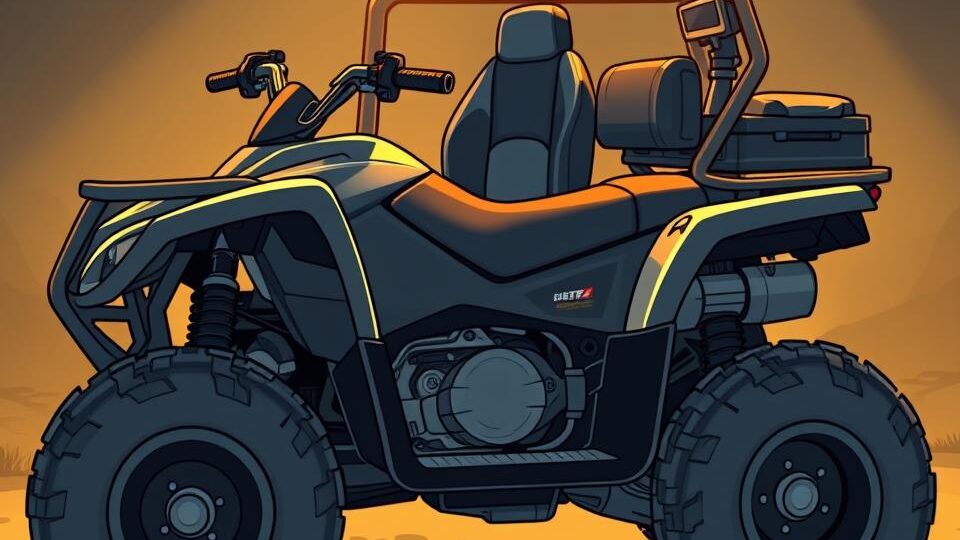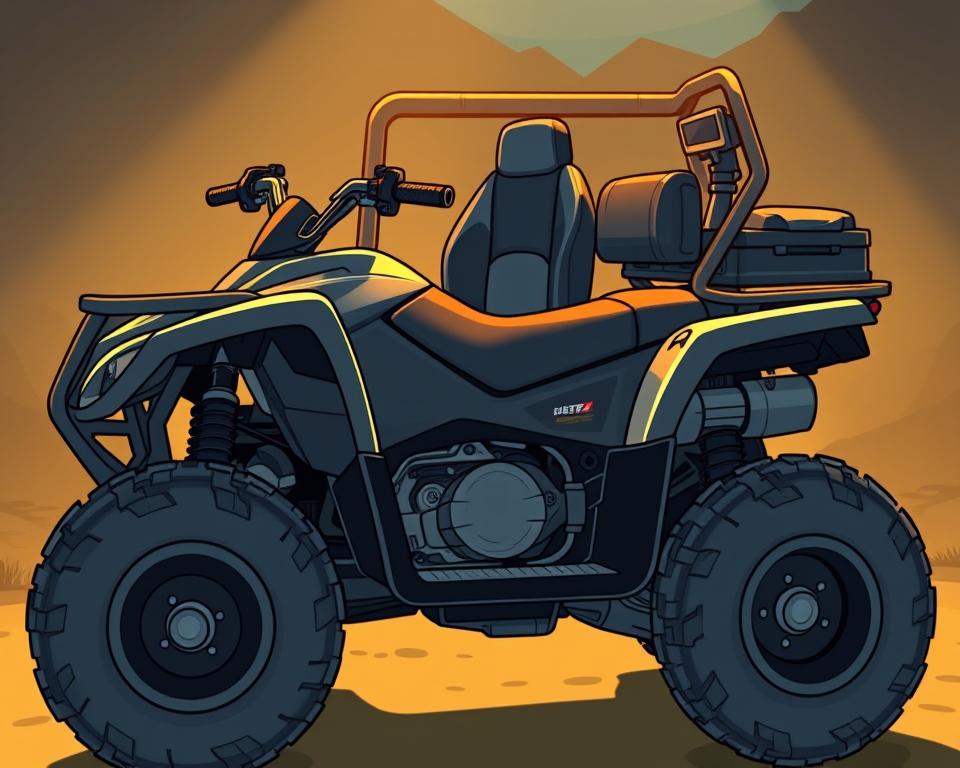
Polaris RZR Accessories Aftermarket to Streamline Controls
Must-Have ATV Off-Road Safety Checklist
Surprisingly nearly some 450,000 ATV-related injuries are treated in U.S. emergency rooms each year? This alarming figure highlights the need for safety and preparedness in off-road adventures. Use this Essential ATV Off-Road Checklist to ensure every ride is safe and fun. It covers everything from rocky trails to sand dunes. Armed with proper safety equipment and RZR stuff must-haves, you’ll reduce hazards and amplify the fun.
Core Lessons
- Start with safety: follow this checklist for full prep.
- Your gear list is critical for staying protected off-road.
- Keep your ATV running smoothly with routine care.
- Hydration and nutrition boost endurance and focus on long rides.
- Don’t wander: rely on trusty navigation tools.
- Weather can flip fast—be ready with proper gear.
- Always carry essential tools and recovery kits for on-trail repairs and emergencies.
Understanding the Importance of Safety Gear
When you ride off-road, safety must come first. The excitement of ATVs brings potential hazards. Protective equipment shields you from crashes and bumps. A full gear check means a safer outing.

Essential Protective Gear
Maximizing protection involves several key items:
- Helmets: Only DOT-certified lids will protect your skull.
- Eye Protection: Use goggles to shield your eyes from dust and debris.
- Riding Gloves: Wear durable gloves for better grip and hand protection.
- Footwear: Wear sturdy boots that cover the ankles to prevent injuries.
- Protective Armor: Chest and back armor add vital protection.
- Neck Braces: Support your neck to prevent serious injury.
Emergency Preparedness
Don’t overlook your emergency kit. Your emergency bag could be your best friend. Key items to include are:
- First aid kit
- Multi-tool
- Tire repair kits
- Portable air compressors
- Emergency blankets
- Whistles
- Matches
ATV Equipment for Optimal Performance
Gear choices affect how well your ATV runs. Knowing the must-have ATV equipment ensures you’re ready for any journey. Regularly following an ATV maintenance checklist helps maintain your machine’s functionality and longevity.
Must-Have ATV Equipment
- All-Terrain Tires: Choose tires that grip mud, sand, and rocks.
- Cargo Systems: Keep tools and spares within reach.
- Fuel Reservoir: Never run low—use a proven fuel tank.
- First Aid Kit: Prepare for emergencies with a well-stocked first aid kit for immediate attention if needed.
Regular Maintenance for Longevity
A maintenance schedule is your ATV’s best friend. Regular inspections should encompass:
- Checking air filters to keep the engine running smoothly.
- Grease your chain often to avoid skip and wear.
- Ensure pads and discs are in prime condition.
Stay on top of upkeep and your ATV will perform its best.
The Essential ATV Off-Road Checklist
Don’t skip your pre-ride safety scan. Use this pre-ride checklist to avert trouble before it starts. Every point matters—don’t rush. Spend a few minutes now for peace of mind later.
Pre-Ride Inspection Basics
Before any off-road journey, a pre-ride inspection is vital. Find and fix small problems before they grow. Key elements to check include:
- Tire pressure and tread condition
- Fluid levels such as oil and fuel
- Brakes and controls functionality
- Operational lights and horn
- Chain or driveshaft integrity
T-CLOC Inspection Method
Use T-CLOC for a thorough pre-ride check. It covers Tires and Wheels, Controls, Lights, Oil and Fuel, and Chain/Driveshaft. This method ensures all critical areas are covered:
| Inspection Area | Checklist Items |
|---|---|
| Tires and Wheels | Check tire pressure, inspect tread depth, look for damage |
| Controls | Test brakes, throttle, and clutch for smooth operation |
| Lights | Ensure headlights, brake lights, and indicators are functioning |
| Oil and Fuel | Check oil level, inspect for leaks, and fill fuel tank |
| Chain/Driveshaft | Examine for wear, proper tension, and lubrication |
Check everything—ride with confidence. By checking these essential components, riders can avoid breakdowns.
Hydration and Nutrition for Long Rides
Stay fueled and hydrated for peak performance. Dehydration slows reaction and focus—pack extra water. Carry extra water to prevent fatigue and keep energy levels up during the adventure. The right snacks are also key for maintaining stamina on the trail.
Importance of Staying Hydrated
Drink often—don’t wait for thirst. It’s important to drink water consistently, not just when thirsty. Backpack reservoirs keep water flowing hands-free.
High-Energy Snacks to Pack
Choosing the right snacks is vital for extended ATV rides. Opt for non-perishable items that are easy to consume. Some ideal choices include:
- Protein bars
- Nut mixes
- Dried fruits
- Beef jerky
These snacks provide a quick energy boost without hindering the riding experience. Variety prevents taste fatigue and keeps you powered.
Navigation Tools for Off-Roading Adventures
Exploring uncharted territory demands reliable navigation tools. Off-road navigation tools are invaluable for staying on track, no matter the terrain.
Advanced GPS Systems
High-end GPS units guide you through the wild. Choose units with rugged builds, offline charts, and extended runtime. Brands like Garmin and TomTom offer models designed for off-road use, ensuring durability and precision.
Traditional Navigation Aids
Technology is key, but traditional tools are also essential. A compass never needs a signal. Knowing how to use these tools is critical, adding security to your excursions. Combining advanced tech with traditional aids prepares you for any situation on your journey.
Communication Equipment for Safety
Stay in touch even off the grid. Communication gear is as critical as your helmet. Talking to your team prevents misadventures.
Don’t split up without radios in hand. These devices ensure clear audio over long distances. Stay informed of detours or emergencies instantly. When choosing two-way radios, look for models with:
- Rugged, waterproof design to resist the elements
- Extended run-time for extended trips without needing a recharge
- Channel selection for clear communication without interference
Always include comms in your gear list. Group comms save time and reduce risk. They provide a vital communication line in tough environments. Clear comms = better rides.
Self-Rescue Gear for ATV Riders
Self-rescue gear is as vital as your helmet. With the right kit, you’ll tackle obstacles solo. A well-prepared rider not only improves their experience but also boosts safety for all.
Winches and Recovery Kits
A winch can drag you out of any rut. Combine winch power with the right accessories. Recovery kits usually include:
- Tow straps
- D-rings
- Recovery boards
- Gloves
Knowledge plus gear equals true self-rescue. Don’t let stuck wheels end your ride.
Trail Recovery Essentials
Pack these extras along with your winch. These include:
| Equipment | Purpose |
|---|---|
| Recovery Straps | Used for towing or pulling ATVs out of tight situations. |
| Shovel | Helps clear obstacles and dig out vehicles when stuck. |
| Traction Mats | Provides grip under tires in muddy or slick conditions. |
| Portable Air Compressor | Enables quick tire inflation after deflating for better traction. |
Arming your ATV with the right self-rescue gear ensures you can handle any obstacles. Skills plus gear equal top-tier off-road safety.
Staying Adaptable: Preparing for Weather Changes
Weather variability is a major challenge in off-roading. Your comfort and safety depend on proper weather prep. Pack for every possible forecast.
Dress in layers to stay comfortable. A dry base keeps you cozy. Mid-layers trap heat and pack small. Lastly, have a waterproof and wind-resistant outer shell. This setup ensures you stay comfortable, no matter the weather.
Weather-Appropriate Clothing
- Rain Shells: A must-have for sudden downpours.
- Ventilated Off-Road Pants: Pants that vent yet keep out the rain.
- Sun Protection: Lightweight, long-sleeved shirts and wide-brimmed hats safeguard against harmful UV rays.
- Insulated Gloves: Warm gloves maintain dexterity in chill.
Don’t let the weather ruin your ride. Comfortable riders ride longer and safer.
Tools for On-Trail Repairs
Your toolkit can make or break your day on the trail. Don’t skimp on repair gear. Tackle trailside trouble with confidence.
Must-Have Tools and Kits
No ride is complete without a toolkit. Pack only the essentials—no junk. Critical ATV repair tools might include:
- Tire irons for changing flat tires
- Pliers for gripping and cutting
- Wrenches for various sizes of bolts and nuts
- A multi-tool for versatility
- Spare items such as spark plugs and electrical wire
- Duct tape for quick fixes
Be your own mechanic on the trail.
Basic Emergency Supplies
In addition to essential tools, packing basic emergency supplies for ATV is vital. These supplies help ensure your safety in challenging situations:
- First aid kit for injuries
- Flashlight with extra batteries for night-time visibility
- Emergency whistle for signaling assistance
- Reflective triangles or flares to warn other riders
- Water and high-energy snacks for sustenance
Preparedness significantly impacts your off-roading experience. Your safety net on the trail.
The Final Word
Preparation is the secret to epic trails. Using the Essential ATV off-road checklist and acquiring gear from trusted sources is key. Ride confidently on every surface.
Load up on safety, navigation, and comms gear. Plan smart to ride hard and safe. It lets you enjoy the thrill of off-road adventures without worry.
Be prepared, ride safe, and make great memories. Every leg of the trip matters. Check this list, then conquer nature.
FAQ
What belongs on an ATV gear list?
Your ATV safety gear checklist should include a DOT-approved helmet and goggles. Add gloves, boots, and torso protection. Neck braces offer additional protection. Remember to pack an emergency kit with a first aid kit and multi-tools for preparedness.
How do I keep my ATV in top shape?
Keep filters clean and chain well-lubed. Always test your brakes before a ride. Regular service keeps your ATV trail-ready.
Explain the T-CLOC check.
The T-CLOC inspection method covers several key areas. It includes checking Tires and Wheels, Controls, Lights, Oil and Fuel, and Chain/Driveshaft. Using T-CLOC guarantees safe, smooth rides.
How much water should I bring on an ATV trip?
Overestimate your water needs. Stay topped off to avoid dehydration. Hydration packs make accessing water easy.
Must-have navigation tools for ATV trips?
Use an off-road GPS unit. Combine this with traditional aids like waterproof maps and compasses.
Why carry two-way radios?
Comms keep groups connected and safe. In no-signal zones, radios shine.
Must-have self-rescue tools?
Every ATV rider should carry a winch and a detailed recovery kit. Have straps, shackles, mats, and gloves on hand.
Tips for weather readiness off-road?
Use a base, mid, and shell layering system. Waterproof gear is necessary to stay dry during unexpected rain. Don’t forget sunscreen and UV-blocking apparel.
Key repair tools for ATVs?
For on-trail repairs, pack a basic tool kit for minor fixes. Include tire irons, pliers, wrenches, a multi-tool, and spare parts like a spark plug.